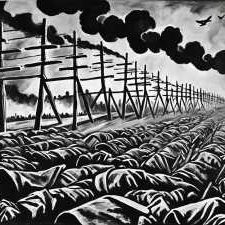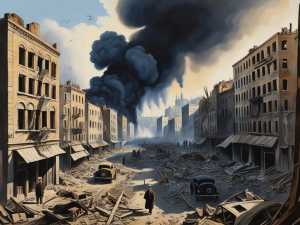Holocaust Complete Timeline – WWII’s Greatest Tragedy

This article describes the Holocaust’s dark past. It shows how segregation led to genocide. Remembering the suffering and dead Jews. We remember concentration camp and Final Solution victims.
May 10, 1933’s boycotts and book burnings reveal humanity’s dark side. We must remember these events to prevent future horrors.
Hatred and intolerance are warned against by the Holocaust. We promise to fight atrocities by sharing these stories. We want a world that learns from history.
Early Years of Nazi Persecution (1933-1934)
Nazi persecution began in January 1933 after Hitler became Chancellor. Key events included the February 1933 Reichstag fire. It gave Hitler full power with emergency laws that deprived Jews of civil liberties.
First Dachau concentration camp opened in March 1933. Initially for political foes, it later held anti-Semitics. Germans boycotted Jewish shops on April 1, threatening Jewish rights. Jews lost their jobs and respect when they couldn’t work in civil service.
Jews were barred from law and medicine. Jewish university students were expelled. Jewish media workers were banned by 1934.
On that same year, Hitler became leader of the Nazi Party after the Night of Long Knives. This eliminated party enemies. Early Nazi rule led to harsher laws and the Holocaust.
| Measure/Action | Details | Year |
|---|---|---|
| Hitler appointed Chancellor | Adolf Hitler becomes Chancellor of Germany | 1933 |
| Reichstag Fire | Emergency decrees issued, suspending civil liberties | 1933 |
| Establishment of Dachau | First concentration camp for political prisoners | 1933 |
| Boycott of Jewish businesses | Germans prohibited from patronizing Jewish businesses | 1933 |
| Professional bans | Jews excluded from civil service, law, medicine | 1933 |
| Night of the Long Knives | Purge of internal party rivals | 1934 |
Escalation of Anti-Jewish Legislation (1935-1936)
Nazi laws from 1935 to 1936 hurt Jews and other minorities. Key Nuremberg Laws made life harder for Jews and others. Jews lost citizenship and voting rights on September 15, 1935. They forbade Jews from marrying or dating non-Jews.
It wasn’t just Jews. It also targeted homosexuals, disabled people, and Jehovah’s Witnesses. Healthcare was one of many areas Jews were expelled from. They couldn’t join the military either.
These harsh policies were hidden at the 1936 Berlin Olympics. Persecution worsened soon after. Nazis opened Sachsenhausen concentration camp, revealing their true intentions.
| Law | Enforcement Date | Key Provisions |
|---|---|---|
| Reich Citizenship Law | September 15, 1935 | Stripped Jews of citizenship, voting rights |
| Law for the Protection of German Blood and Honor | September 15, 1935 | Prohibited Jewish and non-Jewish marriages/relations, displaying national symbols |
| Nuremberg Laws | November 14, 1935 | Defined German and Jewish status; restricted Jews from public office and civil rights |
This period saw the Nazis pass laws that pushed for racial purity. It made being Jewish harder and set the stage for worse things to come.
The Road to Genocide (1937-1939)
The years 1937 to 1939 were crucial in the lead-up to the Holocaust. This period saw political and social changes that increased the Nazi’s plans for genocide.
1937–1939 were crucial to the Holocaust. Political and social changes bolstered Nazi genocide plans.
The March 1938 annexation of Austria gave the Nazis more power to persecute Jews. These changes affected more Jews. Nazis took parts of Czechoslovakia to expand their influence.
With events like 'The Eternal Jew’, anti-Semitic propaganda reinforced Jewish persecution. Jews were forced to register their property and had „J” passports. These steps were meant to drive Jews out but took their rights and property.
Nazi Buchenwald concentration camp opened in 1941, revealing their true intentions. More people hated Jews after watching anti-Jewish shows and movies. Many Jewish places were destroyed during Kristallnacht in November 1938. A violent turn occurred when thousands of Jews were arrested and sent to camps.
Aggression and isolation led to World War II in September 1939. Nazis invaded Poland to carry out large-scale plans. This revealed their systematic plan to kill Jews, setting the stage for worse.
| Event | Date | Significance |
|---|---|---|
| Anschluss | March 1938 | Expansion of anti-Semitic laws to Austria |
| Kristallnacht | November 1938 | Mass violence and incarceration of Jews |
| World War II outbreak | September 1939 | Nazis invade Poland, framework set for mass extermination |
These events quickly moved the Nazis closer to their goal. With the British Empire ruling 25% of the world’s people, the need for action was urgent. But, it was too late to stop the genocide. The path from propaganda to genocide was now clear.
The Holocaust’s Systematic Genocide Begins (1940-1941)
The years 1940-1941 were a dark time. They moved from forced Jewish emigration to a full-scale Holocaust. Ghettos like the Lodz Ghetto were set up, showing the plan for mass killing. At the same time, the Nazis invaded Denmark, Norway, and France, adding more Jews to their horrors.
In March 1941, a big camp near Birkenau started being built. It was meant for 100,000 prisoners of war, leading to the Auschwitz complex. This was a key part of the Holocaust’s industrial killing.
By April 1941, the Buna factory began construction. It used prisoners from Auschwitz, linking forced labour with mass murder.
Operation Barbarossa, the Nazi attack on the Soviet Union, started in 1941. It led to the Babyn Yar massacre in September. Over 33,000 Jews were killed by the Einsatzgruppen in just two days.
Deporting Jews got worse in 1941 and 1942. Around 183,000 Jews were moved from Germany, Austria, and Czech areas. They went to ghettos, killing centres, and places of execution.
Hitler also started a programme to kill disabled people. By 1945, about 275,000 disabled individuals were murdered. Between 1940 and 1941, 70,000 were killed in Austria and Germany.
- 1933: Jews in Germany made up only 1% of the population (about 525,000).
- 1935: Laws were made to define who was Jewish.
- 1939: Many Jews left Germany because of the growing persecution.
- 1940-1941: 70,000 disabled Austrians and Germans were murdered, showing the Holocaust’s start.
These actions in 1940-1941 showed the Nazis’ move to a full-scale genocide. They were getting ready for the Final Solution.
| Event | Details | Impacts |
|---|---|---|
| Lodz Ghetto | Established to isolate Jewish population | Marked the start of creating ghettos |
| Operation Barbarossa | German invasion of the Soviet Union | Significant increase in number of Jews under Nazi control |
| Babyn Yar Massacre | 33,000 Jews killed in two days | Exemplified Einsatzgruppen’s role in the Final Solution |
| Jewish Deportation | Deportation of 183,000 Jews from Germany, Austria, and Czech | Increased fatalities in ghettos and killing centres |
| Euthanasia Programme | Initiated genocide of disabled individuals | Prelude to mass scale genocide within the Holocaust |
The Height of Mass Murder (1942-1943)
The Holocaust was worst in 1942–1943, when Nazi death camps killed tons of people. Key events included the January 1942 Wannsee Conference. Nazi leaders planned the „Final Solution.” to kill millions of Jews.
Operation Reinhard aimed to exterminate all Jews in German-occupied Poland. Millions died in Belzec, Sobibor, and Treblinka. Nearly 1.7 million Jews died in 21 months.
Over a million Jews and others were gassed at Auschwitz. This included Roma, Poles, and Soviet POWs. Chelmno killed 172,000 people from December 1941 to March 1943.
Resistance in the 1943 Warsaw Ghetto Uprising was brave. It defied the Nazis despite being crushed.
Looking at the numbers, the scale of the atrocities is huge:
| Location | Number of Victims |
|---|---|
| Chelmno | At least 172,000 |
| Operation Reinhard Death Camps (Belzec, Sobibor, Treblinka) | 1.7 million |
| Auschwitz-Birkenau | More than 1 million |
| Family Camps (Auschwitz-Birkenau, Lublin/Majdanek) |
10,800 Jews and nearly 2,900 Roma in gas chambers (1944) |
Even with reports of these crimes, many around the world didn’t act. But the Jews showed great courage and resilience. About 300 prisoners managed to escape from Belzec, Sobibor, and Treblinka in 1943.
The Holocaust in 1942-1943 was a dark time for humanity. The Wannsee Conference and death camps show the worst of human cruelty. The Warsaw Ghetto Uprising shows how people resisted in hard times.
The Path to Liberation and Aftermath (1944-1945)
In 1944, Allied forces moved forward, making the Nazi regime retreat. This led to the terrible death marches. Prisoners were forced to march away from freedom.
Conditions in the Third Reich were dire. Almost 714,000 prisoners were in the concentration camps by January 1945.
Events like the mass deportation of Hungary’s Jews showed the harsh reality. Denmark, however, bravely tried to save its Jews. The liberation of Paris and the Battle of the Bulge were key moments for the Allies.
The Warsaw Uprising showed the strong resistance of Jews and locals against the Nazis.
The Soviet troops liberated Auschwitz on January 27, 1945, revealing the Holocaust’s true extent. By May 1945, with Hitler’s death and Germany’s surrender, the world began to understand the Holocaust’s scale. About 250,000 prisoners didn’t survive to see freedom.
This period led to post-war justice through trials. It changed the world, remembering the loss of 11 million people, six million of whom were Jews. It made the promise of 'Never Again’ even stronger.
FAQ
What marked the beginning of the Holocaust?
Adolf Hitler became Chancellor on January 30, 1933. This started Nazi tyranny and the persecution of Jews. It led to the use of concentration camps and anti-Semitic policies.
What was significant about the Reichstag fire?
The Reichstag fire on February 27, 1933, helped Hitler to take away civil liberties. It led to the first concentration camp, Dachau, on March 22, 1933. This event helped Hitler to persecute Jews and political enemies more easily.
How did Hitler establish a dictatorial rule in Germany?
Hitler made himself more powerful with the Enabling Act. This act let him make laws without asking parliament. After President von Hindenburg died on August 2, 1934, Hitler became Führer. He held both the Chancellor and President roles.
What were the early impacts of Nazi anti-Semitic policies?
Early effects included a boycott of Jewish businesses on April 1. Jews were also banned from civil service, education, and journalism. Laws made them lose citizenship and face compulsory sterilisation.
What role did ghettos play during the Holocaust?
Ghettos, like the Lodz Ghetto from 1940, were places to keep Jewish people apart. Conditions in ghettos were very bad. They were also where Jews were sent to death camps as part of the Final Solution.
What was the significance of the Wannsee Conference?
The Wannsee Conference in January 1942 made clear plans to kill all Jews. This led to the creation of death camps like Bełżec, Sobibór, and Treblinka, where many Jews were murdered.
How did the Allied forces contribute to the Holocaust’s end?
Allied forces helped by moving into Nazi areas and finding concentration camps. For example, Soviet troops found Auschwitz on January 27, 1945. This showed the world the true horrors of the Holocaust.
What happened after the Holocaust?
After the Holocaust, there were war tribunals like the Nuremberg Trials. These trials punished Nazi leaders for their crimes. They made the world remember and acknowledge the Holocaust’s horrors.


